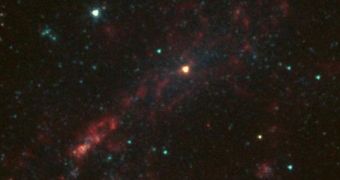In a new study conducted using the NASA Wide-field Infrared Survey Explorer (WISE) space telescope, astronomers were able to identify what they believe to be the seeds of supermassive black holes. These structures may represent the foundations on which massive objects millions to billions of times heavier than the Sun form.
The exact mechanism through which supermassive black holes form has eluded astrophysicists for many years, but the new study may finally bring this understanding a step closer to reality. These very heavy and dense objects are believed to lie at the core of every galaxy. The one that occupies the center of the Milky Way is called Sagittarius A*, and it is 2.6 million times heavier than the Sun.
Figuring out how supermassive black holes came to be is extremely important, since this will lead to a better understanding of how large galaxies evolved as well. The fact that galaxies and black holes influence each other's growth patterns has been thoroughly documented, but the nature of this link still holds many mysteries to researchers.
For reference, small black holes tip the scales at just a few solar masses, and they usually form following type II supernova events, when massive stars reach the end of their burning cycle and implode. Their cores collapse into either a neutron star, or a small black hole. However, some black holes can grow to gargantuan sizes, and move to the cores of galaxies.
These are the objects astronomers are interested in learning more about. In the new study, experts with the George Mason University in Fairfax, Virginia, used WISE to look for signs of massive black holes inside smaller, dwarf galaxies. The team used this telescope because it is sensitive to infrared light.
This enables it to peer through the massive clouds of dust and gas that are believed to surround black holes as they feed. WISE data revealed that the sizes of black holes in dwarf galaxies range between 1,000 and 10,000 solar masses. These values are much larger than what had been anticipated for galaxies of this size and mass.
“Our findings suggest the original seeds of supermassive black holes are quite massive themselves,” says GMY investigator Shobita Satyapal. The expert is the lead author of a new paper detailing the findings, which appears in the March issue of the esteemed Astrophysical Journal.
“Though it will take more research to confirm whether the dwarf galaxies are indeed dominated by actively feeding black holes, this is exactly what WISE was designed to do: find interesting objects that stand out from the pack,” says astronomer Daniel Stern, who was not a part of the new study. He is based at the NASA Jet Propulsion Laboratory (JPL) in Pasadena, California, which manages WISE.
The new findings are very interesting because they go against established theories suggesting that black holes may grow through constant intergalactic collisions and mergers. However, the new conclusions indicate that black holes may not necessarily require galactic mergers to grow in mass. One possible explanation is that they grow in tune with their host galaxies, feeding off the gas clouds within.
“We still don't know how the monstrous black holes that reside in galaxy centers formed. But finding big black holes in tiny galaxies shows us that big black holes must somehow have been created in the early universe, before galaxies collided with other galaxies,” Satyapal concludes.

 14 DAY TRIAL //
14 DAY TRIAL //